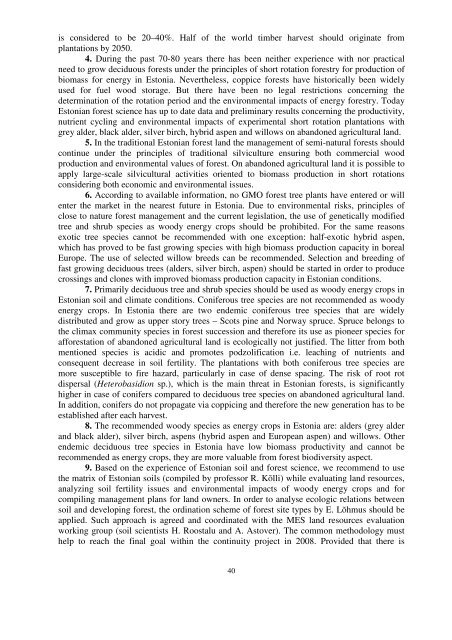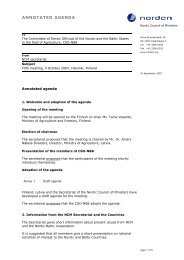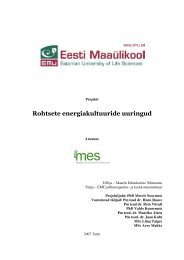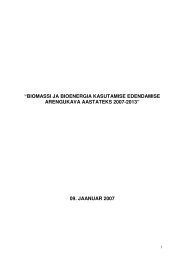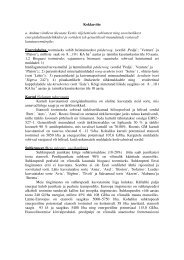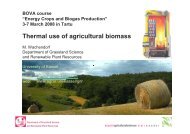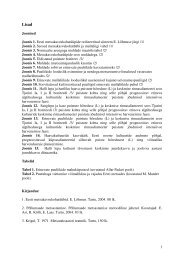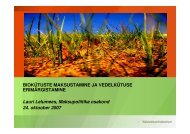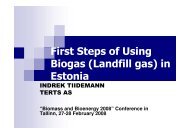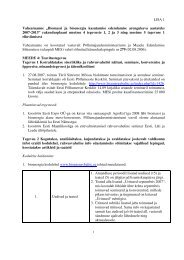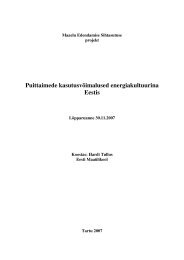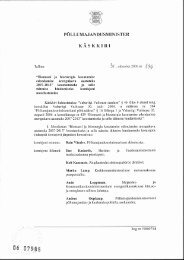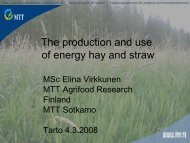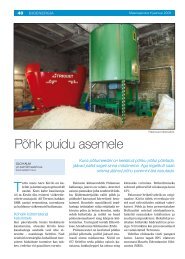Põllumajandusministeeriumi ja Maaelu ... - bioenergybaltic
Põllumajandusministeeriumi ja Maaelu ... - bioenergybaltic
Põllumajandusministeeriumi ja Maaelu ... - bioenergybaltic
You also want an ePaper? Increase the reach of your titles
YUMPU automatically turns print PDFs into web optimized ePapers that Google loves.
is considered to be 20–40%. Half of the world timber harvest should originate from<br />
plantations by 2050.<br />
4. During the past 70-80 years there has been neither experience with nor practical<br />
need to grow deciduous forests under the principles of short rotation forestry for production of<br />
biomass for energy in Estonia. Nevertheless, coppice forests have historically been widely<br />
used for fuel wood storage. But there have been no legal restrictions concerning the<br />
determination of the rotation period and the environmental impacts of energy forestry. Today<br />
Estonian forest science has up to date data and preliminary results concerning the productivity,<br />
nutrient cycling and environmental impacts of experimental short rotation plantations with<br />
grey alder, black alder, silver birch, hybrid aspen and willows on abandoned agricultural land.<br />
5. In the traditional Estonian forest land the management of semi-natural forests should<br />
continue under the principles of traditional silviculture ensuring both commercial wood<br />
production and environmental values of forest. On abandoned agricultural land it is possible to<br />
apply large-scale silvicultural activities oriented to biomass production in short rotations<br />
considering both economic and environmental issues.<br />
6. According to available information, no GMO forest tree plants have entered or will<br />
enter the market in the nearest future in Estonia. Due to environmental risks, principles of<br />
close to nature forest management and the current legislation, the use of genetically modified<br />
tree and shrub species as woody energy crops should be prohibited. For the same reasons<br />
exotic tree species cannot be recommended with one exception: half-exotic hybrid aspen,<br />
which has proved to be fast growing species with high biomass production capacity in boreal<br />
Europe. The use of selected willow breeds can be recommended. Selection and breeding of<br />
fast growing deciduous trees (alders, silver birch, aspen) should be started in order to produce<br />
crossings and clones with improved biomass production capacity in Estonian conditions.<br />
7. Primarily deciduous tree and shrub species should be used as woody energy crops in<br />
Estonian soil and climate conditions. Coniferous tree species are not recommended as woody<br />
energy crops. In Estonia there are two endemic coniferous tree species that are widely<br />
distributed and grow as upper story trees – Scots pine and Norway spruce. Spruce belongs to<br />
the climax community species in forest succession and therefore its use as pioneer species for<br />
afforestation of abandoned agricultural land is ecologically not justified. The litter from both<br />
mentioned species is acidic and promotes podzolification i.e. leaching of nutrients and<br />
consequent decrease in soil fertility. The plantations with both coniferous tree species are<br />
more susceptible to fire hazard, particularly in case of dense spacing. The risk of root rot<br />
dispersal (Heterobasidion sp.), which is the main threat in Estonian forests, is significantly<br />
higher in case of conifers compared to deciduous tree species on abandoned agricultural land.<br />
In addition, conifers do not propagate via coppicing and therefore the new generation has to be<br />
established after each harvest.<br />
8. The recommended woody species as energy crops in Estonia are: alders (grey alder<br />
and black alder), silver birch, aspens (hybrid aspen and European aspen) and willows. Other<br />
endemic deciduous tree species in Estonia have low biomass productivity and cannot be<br />
recommended as energy crops, they are more valuable from forest biodiversity aspect.<br />
9. Based on the experience of Estonian soil and forest science, we recommend to use<br />
the matrix of Estonian soils (compiled by professor R. Kõlli) while evaluating land resources,<br />
analyzing soil fertility issues and environmental impacts of woody energy crops and for<br />
compiling management plans for land owners. In order to analyse ecologic relations between<br />
soil and developing forest, the ordination scheme of forest site types by E. Lõhmus should be<br />
applied. Such approach is agreed and coordinated with the MES land resources evaluation<br />
working group (soil scientists H. Roostalu and A. Astover). The common methodology must<br />
help to reach the final goal within the continuity project in 2008. Provided that there is<br />
40


